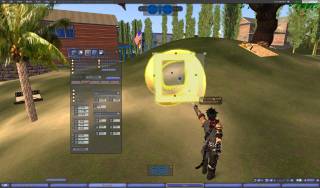Overview
 Anko from Naruto is one of the many Avatars you can buy in Second Life
Anko from Naruto is one of the many Avatars you can buy in Second LifeSecond Life is a virtual world created, hosted and owned by a company called Linden Lab where every bit of content that you see is created by the people that are in it. Almost everything that a person can think of can either be found, bought, or created in Second Life - whether it's an avatar that looks like a cat, transformer, Master Chief lookalike - perhaps a virtual club or a roleplay area with a specific rule set. Due to the flexibility regarding what can be done in the game, abstract virtual fetishes have developed over time. The people that populate the world of Second Life (aka The Grid) do so as avatars, 3D virtual representations of themselves that can be customized as they see fit. Communication between avatars can either be conducted in a public chat, private instant messages, or group chats--all of which can either be done through the use of voice or regular text chat.
As far as goals go, there are none other than the ones a person sets for themselves. And thanks to the fact that everyone is different, there is a great diversity of content to be found within the game (some of it being more niche than other things).
Getting Started
Getting started in Second Life is as easy as signing up for a free basic account at their website where you pick the name of the avatar that you will use to represent yourself in-world (of which the first name is entirely of your choosing and the last name a list of choices), and a simple starting appearance. Once you have successfully completed the signup process you need to download and install the Second Life Viewer, which is the client software that allows you to connect to the service and enter the Second Life Grid. Every new avatar that joins the game gets dropped at one of the tutorial islands, where they learn the basics such as moving around, using search, the map, and teleporting.
With the introduction of land covenants, it became a lot easier for people with virtual land to sublet to other people, negating the necesity of getting a premium account to get a house. This spurred a large increase in Second Life players dealing in virtual real estate.
Premium Accounts
If one wishes, it's also possible to opt for a premium account which gives you various benefits such as being a able to buy a small (512m) plot of virtual land, get priority support, and receive a weekly stipend of in-world currency called Linden Dollars (L$) that can be used to purchase various items in the world. However, due to the ever-increasing open-source approach of Linden Lab, the ability to earn L$ through various in-world jobs, and the option of 'renting' land from other users, the average Second Life resident will find that they have no need for a premium account. And should you really have a need for something but not have the required amount of L$ to get it, you can always purchase more of the virtual currency using real money.
Linden Homes
As of February 17, 2010, people with a premium account can get a Linden Home. This is completely free, but it does use up the 512m of your land tier.
Economy
Like most other online games, Second Life, too, has its own virtual economy, which is based on the exchange of virtual currency called Linden Dollars. Unlike most other online games, however, Linden Dollars can be freely exchanged for real money. This allows residents to trade the money they earned in-world for actual cash. Due to this approach, the option exists for users to generate an actual income. Some people actually earn enough money through their Second Life bussiness that they no longer require a job in the real world. Due to the low exchange rate of the L$, however, and the constantly growing population in the game, it's becoming increasingly difficult to create unique, competitive content that will allow one to generate a viable income.
Content Creation
Pretty much everything you see in the game is content by Second Life residents using various in-game and third-party tools. Such content can be scripts, objects, clothing, or a combination thereof.
Building
 Simple example of building tools
Simple example of building toolsBuilding objects in Second Life can be achieved by using standard tools available in the game itself. Each object built consists of so called prims, which are basically the building blocks of said object, and there is a maximum amount of prims that can be used for an object you create. Depending on whether it incorporates physics or not, this limit can be higher or lower. Prims are easily created by right clicking on any land that has building enabled (land owners can choose to enable or disable building) and hitting the create button. This will "rez" a standard block of which you can alter various properties such as its shape, size, default action, etc. Depending on the complexity of what you're trying to create, a different number of prims need to be individually shaped and linked together to get a satisfactory end result. This means that one can create a simple wall structure consisting of a single prim, simply by resizing it, or you can create more complicated things like vehicles, attachments for avatars to wear, and what not to wear. Obviously the more complex the object you're trying the create, the more skill and time it requires.
Content that you create this way can also have scripts, which you can either add to the object as a whole or an individual prim of said object.
Scripting
Second Life uses its own scripting language called Linden Scripting Language, but it's more commonly referred to as simply LSL, and it has a syntax similar to that of a C/Java-style language. LSL can be used to asign different behaviours to various objects, such as the ability to interact with the avatars in the game's world, sending out e-mails, or communcating with websites. Examples range from a simple script to make an object rotate around its own axis, to far more complex scripts that allows an object to fully interact with a website where content created by other users are listed for sale. Of course like all solid scripting languages, LSL can be quite a challenge to learn, so most people will resort to either buying something that alread has the desired fuction, or paying someone to make a custom script. And while there is enough material to learn LSL, a lot of it is spread out and largely unorganized, making it a daunting task to learn the language for beginners.
Trivia
Open Simulator
In 2007 a group of open source developers got together and coded their own virtual world's platform, Open Simulator(or OpenSim) which is based on Second Life protocols and has a very similar look and feel. It is also possible to download content you made in Second Life to an Opensim grid to use, sell or give away. The most significant difference is that OpenSim is available to anyone to download and set up their own world free of charge other than the cost of server hosting but it can be run on a home computer and linked to one of the established grids like OSgrid.

OpenSim was made possible because Linden Labs released their viewer code to the open source community when, at that time in 2007, the Lab was keen to explore shared interoperability between virtual worlds. This lead to avatars being able to grid hop or teleport between Second Life and OpenSim worlds. However, Linden Labs had a change of mind and shut down the project but the OpenSim community continued to grow and develop. The experiments with grid hopping lead to more advanced processes enabling what became known as Hypergrid which allowed avatars to continue teleporting with their full appearance and inventory. Today, Hypergrid forms an important part of the OpenSim Metaverse enabling many content makers and game builders to express their creativity and flair at a fraction of the cost of Second Life.
Today their are over 200 OpenSim grids both small and large. OSgrid is the biggest and the original developer's grid which is run on donations but there are many more including commercial grids with their own economies and token currencies.
Log in to comment